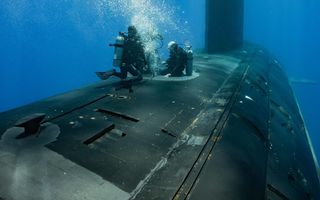The headlines
One of the key questions for those who follow Australia-US strategic relations is: Does President Trump know what AUKUS is? During UK Prime Minister Keir Starmer's visit to the White House in February a journalist asked the president about AUKUS and he replied: “what does that mean?”
In many ways Trump’s lack of knowledge on AUKUS is troubling. It is, after all, a key trilateral engagement with two key US allies: the United Kingdom and Australia. Yet at the same time the president’s lack of insight into one of the dozens of contemporary US minilateral agreements and defence technology pacts is unsurprising. Trump is known for not taking an interest in detailed security briefings and the AUKUS pact is a legacy policy from the Biden administration. However, Secretary of Defense Pete Hegseth has remarked “The President is very aware, supportive of AUKUS, recognizes the importance of the defense industrial base.” In addition, Australia’s newly elected Prime Minister Anthony Albanese said that he had a “very warm” phone call with President Trump after his thumping election victory that included a discussion of AUKUS.
What is happening behind the headlines?
Often mischaracterised as a security ‘alliance,’ AUKUS, is in fact, about the development, and transfer of, critical defence technology between the three countries.
AUKUS was an Australian idea. At its core is the development of a sovereign owned and operated conventionally-armed nuclear-powered submarine (SSN) capability for Australia. This is seen as essential to protecting Australia’s maritime interests and for providing deterrence in an age characterised by the risk of major power conflict in the Indo-Pacific.
The program is high reward for all countries involved but also high risk given the nature of the technology and the pact’s component parts. Pillar I consists of the forward rotation of US and UK SSN’s in Western Australia (from 2027), followed by the sale of US Virginia class submarines to Australia – to bridge Australia’s looming submarine capability gap – before the delivery of SSN AUKUS: a UK-Australia jointly designed and built submarine based on US reactor technology, seniors, combat system and weapons. Pillar II is the development of ‘Advanced Capabilities’ such as AI, hypersonics, quantum and cyber for military applications.

The question of the president’s knowledge of AUKUS is far less importance than the pursuit of AUKUS as a policy aim in the new administration and its support in the legislative branch.
AUKUS has emerged as a clear defence priority of the Trump administration thus far. Secretary of Defense Pete Hegseth’s confirmed as much in his first international meeting with Australia’s Deputy Prime Minister and Defence Minister Richard Marles on 8 February 2025, saying “Australia is the forefront of our alliance [in the Indo-Pacific] and throughout the world, there’s just no doubt about it…So as far as defence is concerned; force posture, defence industrial base, joint capabilities cooperation and AUKUS, of course, are signature parts [of the Alliance relationship].”
In Congress there remains a strong bipartisan AUKUS Caucus as well as robust support from powerful legislators such as Congressman Joe Courtney (D-CT), Senate Armed Services Committee Chairman Roger Wicker (R-MS), and House Armed Services Committee Chairman Mike Rogers (R-AL).
AUKUS is bipartisan in all three countries, but the key challenges are less about political will and rather about the ability to deliver on both Pillar I and Pillar II.
Key debates around the issue
Delivery is key and delivery starts with adequate funding and policy.
Pillar I is essential to Australia receiving an SSN capability and the United States and United Kingdom maintaining their capability. In Congress, the greatest debate is over funding of the US defence budget generally and, specifically for AUKUS, the funding and efficiency of the US Submarine Industrial Base (SIB). Here the Trump administration has been off to a good start. In February, Secretary Hegseth announced a US$50 billion reallocation of the US defence budget, which included naval shipbuilding and the SIB as top priorities. After years of calling for increased defence spending, senior Republican lawmakers like Senator Roger Wicker were confident that defence spending would rise around US$200 billion under the new administration. President Trump has boasted of the first trillion dollar defence budget. The initial rhetoric over the need to revive US naval shipbuilding and the SIB plus a broader commitment to increasing defence spending to achieve ‘peace through strength’ meant that the Trump administration initially seemed to be doing much more to deliver on Pillar I compared to the Biden administration.
From FY2011 through FY2024, the time between the appropriation of funds for SSNs and their delivery has increased from six years to nine years.
This is an important development. Since 2011, the Congress has authorised and appropriated funds for the US Navy to buy two Virginia class submarines per year. Yet US shipyards have only been capable of building 1.2 SSNs per year – generating a massive backlog of work and reducing the size of the US SSN fleet. From FY2011 through FY2024, the time between the appropriation of funds for SSNs and their delivery has increased from six years to nine years. This is both a problem for the US Navy and the biggest risk to the sale of three Virginia class SSNs to Australia in the early 2030s. As a result, the AUKUS deal includes Australia direct injecting US$3 billion into the SIB, with the first US$500 million provided to the United States from the Australian Government in February 2025.
The positive rhetoric coming out of the Trump administration on defence spending uplifts came crashing down in early May 2025. The budget reality and policy rhetoric have clashed. Senior congressional Republicans savagely rejected the Trump defence budget proposal. While the Trump administration called it a trillion dollar budget, top Republicans “said the actual budget documents only indicate a plan to fund national defence at $892.6 billion, roughly in line with recent defence budgets under former President Joe Biden.” Senator Wicker noted that “For the defense budget, OMB [Office of Management and Budget] has requested a fifth year straight of Biden administration funding, leaving military spending flat, which is a cut in real terms.”
The one bright light in the SIB funding debate has been the announcement of the US Navy’s (USN) new US $17 billion contract for two Virginia-class submarines that was focused around explicit funding for workforce-related needs such as wage increases, hiring and shipyard productivity improvements for the first time. This provides not just funding for the building of submarines but also to ensure adequate labour force to deliver them. This is good progress but US$17 billion and two SSNs are just the tip of the iceberg.
While Pillar I remains a strategic priority in all three countries, Pillar II has emerged as at the most risk.
On top of budget issues, the early days of the administration has not been matched by policy focus and discipline. The loss of senior personnel in the Pentagon and the lack of policy focus or clear direction has led to accusations of ‘chaos’ in the Pentagon. The Secretary has responded by saying “The media likes to call it chaos, we call it overdue,” and clarifying that his focus has been on ensuring “no more social engineering. No more climate change worship. No more electric tanks. No more gender confusion. No more pronouns. No more excuses. No more quotas. No more woke bullshit that undermines commanders and command climates.”
While Pillar I remains a strategic priority in all three countries, Pillar II has emerged as at the most risk. The less high profile of the two parts of AUKUS, it has been exceptionally slow in developing and has yet to produce meaningful capability ‘in the hands of the war fighter’.

Originally billed as being the short term delivery piece of AUKUS, the lack of progress has led senior leaders in Australia and the United Kingdom to claim that short terms goals (6+ years after announcement) will be achieved through Pillar I Submarine Rotational Force West (SRF-W) as the near term delivery. The other initial benefit being touted is the delivery of enabling legislation for industry and the three governments to develop an AUKUS style defence ‘free trade’ sector between all three countries. While exceptionally important, and not to be underestimated, such policy development does not in itself deliver capability. With little progress on Pillar II coupled with an ongoing aura of vagary and lack of dedicated funding lines in any of the three countries, Pillar II is at risk of the loss of political will.
Inside the United States, Pillar II remains underdone. However, if the Trump administration decided to make this a major priority, especially through dedicated flagship programs and funding, this could easily revitalise the Pillar II program of work. Conversely, if the United States sees the program as not delivering value it could be subject to DOGE-style cutbacks.
The implications
The stakes for AUKUS success are greater than what it may seem. While Australia is planning on receiving a new capability in SSNs, this trilateral program of work is critical to the flagging US and UK submarine industrial bases, to US force posture and presence in the Indo-Pacific and to the ongoing development of military technology in a period of major power strategic competition.
One of the greatest benefits of close cooperation with the United States is access to advanced US military technology and industrial capability. This is at a scale that neither country could replace.
If the United States fails to increase its rate of SSN production, it will face critical shortages in one of its most effective military platforms at a time of extraordinary strategic need. If this occurs, Australia faces the real prospect of a submarine capability gap between the end of life of its current diesel-electric capability and the entry to service of the new SSN AUKUS.
More broadly for the United Kingdom and Australia, the scale of the AUKUS enterprise and benefits should not be underestimated. One of the greatest benefits of close cooperation with the United States is access to advanced US military technology and industrial capability. This is at a scale that neither country could replace. This year, the UK defence budget sits at £53 billion GBP (US$70 billion) and the Australian defence budget at A$55 billion (US$34 billion): together this is US$105 billion. For 2024-2025, the Pentagon’s research and development budget alone sits at US$141 billion, out of a broader US$850 billion defence budget. For the United States the rise of great power competition and the decentralisation of innovation across the economy has seen US military superiority in relative decline and under increasing pressure. The ability to aggregate military technology capability through arrangements such as AUKUS is thus central to overall strategic competition and to the United States continuing to have superior capability over key adversaries.
What to watch moving ahead
The key immediate debate is over the size and priorities of the US defence budget as well as the focus and investment from the United Kingdom and Australia in both pillars of AUKUS. Reform to acquisition process in all three countries are major priorities to improve defence spending efficiencies. In addition, the ability for defence industry to receive policy clarity and investment certainty to capitalise on the AUKUS trade liberalisation will also be important. Ultimately, the most important question will be whether US shipyards can increase the production rate of Virginia-class SSNs.
What should allies like Australia do about it?
AUKUS — and not just Pillar I of the program — must remain a political priority in all three countries.
Revised, narrowed priorities and flagship programs need to be agreed on quickly, and clear deadlines must be set. The key to success will then be rigorous political oversight.
Pillar II needs a significant increase in direction and oversight by the US Secretary of Defense, UK Secretary of Defence and the Australian Minister of Defence. Revised, narrowed priorities and flagship programs need to be agreed on quickly, and clear deadlines must be set. The key to success will then be rigorous political oversight.
For Pillar I, the United States needs to provide more funding for the SIB. The USN’s new US$17 billion submarine deal for the latest two Virginia-class submarines is just the tip of the funding iceberg. More investment into workforce and production capacity must be done in all three countries.
To improve coordination across government, Australia must move to appoint an AUKUS Tsar in the Prime Minister’s Office emulating recent moves in the United Kingdom by Prime Minister Sir Keir Starmer.
Unpacking Trump 2.0








.jpg?rect=795,0,2010,2400&w=320&h=382&fit=min&auto=format)
